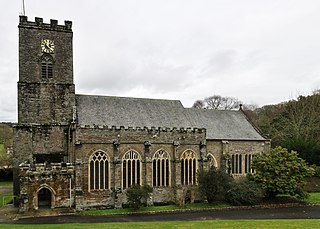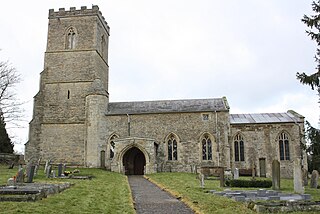
Sudbury is a market town in Suffolk, England, on the River Stour near the Essex border, 60 miles (97 km) north-east of London. At the 2011 census, it had a population of 13,063. It is the largest town in the Babergh local government district and part of the South Suffolk constituency.

Clare is a market town on the north bank of the River Stour in Suffolk, England. Clare is in southwest Suffolk, 14 miles (23 km) from Bury St Edmunds and 9 miles (14 km) from Sudbury. Clare won Village of the Year in 2010 and Anglia in Bloom award for Best Large Village 2011 for its floral displays in 2011. In March 2015, The Sunday Times and Zoopla placed Clare amongst the top 50 UK rural locations, having "period properties and rich history without the chocolate-box perfection – and the coach trips".

St German's Priory is a large Norman church in the village of St Germans in south-east Cornwall, England, UK.

Leeds is a village and civil parish in the Maidstone district of Kent, England.

Grafton Regis is a village and civil parish in the south of the English county of Northamptonshire. The population of the civil parish at the 2001 census was 152. This increased to 253 at the 2011 census. The village is east of the A508 road, on which it has a short frontage and two bus stops. It is ca. 8 miles (13 km) south of Northampton and 9 miles (14 km) north of Milton Keynes.

Stoke-by-Nayland is a village and civil parish in the Babergh district, in the county of Suffolk, England, close to the border with Essex. The parish includes the village of Withermarsh Green and the hamlets of Thorington Street and Scotland Street. The village has many cottages and timber-framed houses and all surround a recreation field. Possibly once the site of a monastery, the population of the civil parish at the 2001 census was 703, falling to 682 at the Census 2011.

Elmstone Hardwicke is a village and sizeable parish north-west of Cheltenham in Gloucestershire, England.

Long Melford, colloquially and historically also referred to as Melford, is a large village and civil parish in the Babergh district, in the county of Suffolk, England. It is on Suffolk's border with Essex, which is marked by the River Stour, 3 miles (4.8 km) from Sudbury, approximately 16 miles (26 km) from Colchester and 14 miles (23 km) from Bury St Edmunds. It is one of Suffolk's "wool towns" and is a former market town. The parish also includes the hamlets of Bridge Street and Cuckoo Tye.

Abthorpe is a village and civil parish in the valley of the River Tove in West Northamptonshire, England, about 4 miles (6.4 km) west of Towcester, 2 miles (3.2 km) northwest of Silverstone and approximately midway between London and Birmingham.

Poslingford is a village and civil parish in the West Suffolk district of Suffolk in eastern England, near to a stream that feeds the into the Chilton stream and then the Suffolk Stour. The main part of the village follows the line of The Street, rising approximately 40 metres in height above sea level from south to north.
Stoke College in Stoke-by-Clare, near Haverhill, Suffolk, England, is a co-educational day school for children aged 11 to 18, with boarding for children aged 11 to 18. It is built on the site of a major medieval monastic college.
Whitchurch is a parish and a small hamlet lying on the left bank of the River Stour in Warwickshire, England, some four miles south-south-east of the town of Stratford-upon-Avon.

Edwardstone is a village and civil parish in the Babergh district, in the county of Suffolk, England. The parish contains the hamlets of Mill Green, Priory Green, Round Maple and Sherbourne Street, and Edwardstone Woods, a Site of Special Scientific Interest. The parish touches Boxford, Great Waldingfield, Groton, Little Waldingfield, Milden and Newton.

Offington is a neighbourhood of Worthing, in the borough of Worthing in West Sussex, England. It lies on the A2031 road 1.6 miles (2.5 km) northwest of the town centre.

Christ Church and its burial grounds in Worthing, England, were consecrated in 1843 by the Bishop of Chichester, Ashurst Turner Gilbert, to meet the need for church accommodation for the poor. Built by subscription between 1840 and 1843, the Church was initially regarded as a chapel of ease to St Mary's Church in Broadwater. The chapel of ease was upgraded to the status of church with its own parish in 1855.
Shouldham Priory was a priory in the village of Shouldham, Norfolk, England.

St Mary the Virgin's Church, Cavendish is a Grade I listed parish church in the Church of England in Cavendish, Suffolk.
William Gage was a major landowner and the father of the Tudor courtier Sir John Gage KG.

Sir John de Pulteney or Sir John Poultney was a major English entrepreneur and property owner, who served four times as Mayor of London.
Stoke-by-Clare Priory was a Benedictine monastery in Stoke-by-Clare, in Suffolk, an alien priory, dependent on Bec Abbey, in Normandy. Reinstituted in 1124, the Priory was suppressed in 1415.
















